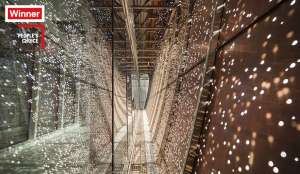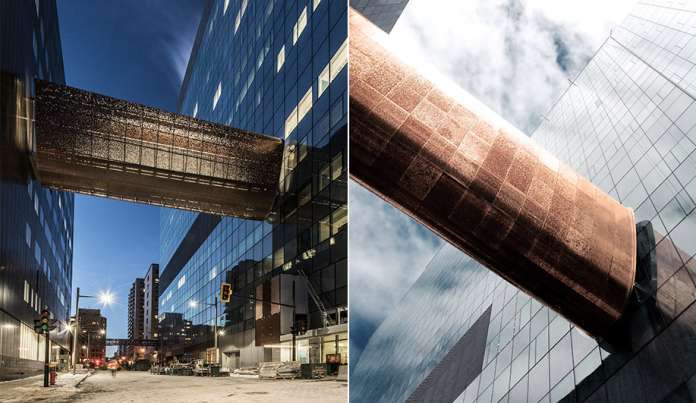More often than not, the bridges and byways that consume so much of our urban space are built for function and nothing more. Especially in cities like Montreal, where civic pride and tourism are so dependent on the architectural richness of the streets, dull infrastructure can be a real visual downer. Alternatively, it can become a focal point. Local firm NEUF Architect(e)s, in collaboration with Cannon Design, has turned a potentially run-of-the-mill sky bridge between two glass towers into a powerful work of art.
 ”This is an exemplary project where the perforations turn the bridge into a light installation that works brilliantly at night and during the day.” – Theo Richardson
”This is an exemplary project where the perforations turn the bridge into a light installation that works brilliantly at night and during the day.” – Theo Richardson
Called Passerelle, the street-spanning passage is part of North America’s newest and largest teaching hospital complex, and serves as a vital link between the Centre hospitalier de l’Université de Montréal (more commonly referred to as CHUM) and the university’s logistics tower.
Floating 18.3 meters above the street, Passerelle’s curved, blimpish shape is clad in sheets of polished copper – a nod to the oxidized rooftops of so many of the city’s churches and cathedrals. Some 197,838 holes have been punctured into its skin to let natural light pour in with a dappled effect during the day, and to lend the structure a celestial quality after dark. Nurses, en route from the blood bank in one building to the operating rooms in the other, now glide through Passerelle’s changing theatrical display with urgent deliveries of blood pellets.
Azad Chichmanian, Son of Souren Chichmanian & Rita Dervishian, is a graduate of Armen Quebec Alex Manoogian school
 Having worked in Montreal, New York and the southern United States, Azad has twenty-some years of international and local experience. As a partner with NEUF architect(e)s since 2007, he leads a dynamic multidisciplinary team that works on a variety of projects in several fields of activity. In association with Cannon Design, NEUF architect(e)s has been a key player in the design and execution of the new CHUM (Centre hospitalier de l’Université de Montréal). Azad played an important role in redesigning the initial programme to adapt the complete programme to a very constraining urban site, thus permitting the consortium to deliver nearly all clinical services in a single accelerated phase.
Having worked in Montreal, New York and the southern United States, Azad has twenty-some years of international and local experience. As a partner with NEUF architect(e)s since 2007, he leads a dynamic multidisciplinary team that works on a variety of projects in several fields of activity. In association with Cannon Design, NEUF architect(e)s has been a key player in the design and execution of the new CHUM (Centre hospitalier de l’Université de Montréal). Azad played an important role in redesigning the initial programme to adapt the complete programme to a very constraining urban site, thus permitting the consortium to deliver nearly all clinical services in a single accelerated phase.
We extend our heartfelt Congratulation to Azad for his remarkable achievement as a talented architect and wish him continued success in his brilliant career. (ABAKA)














